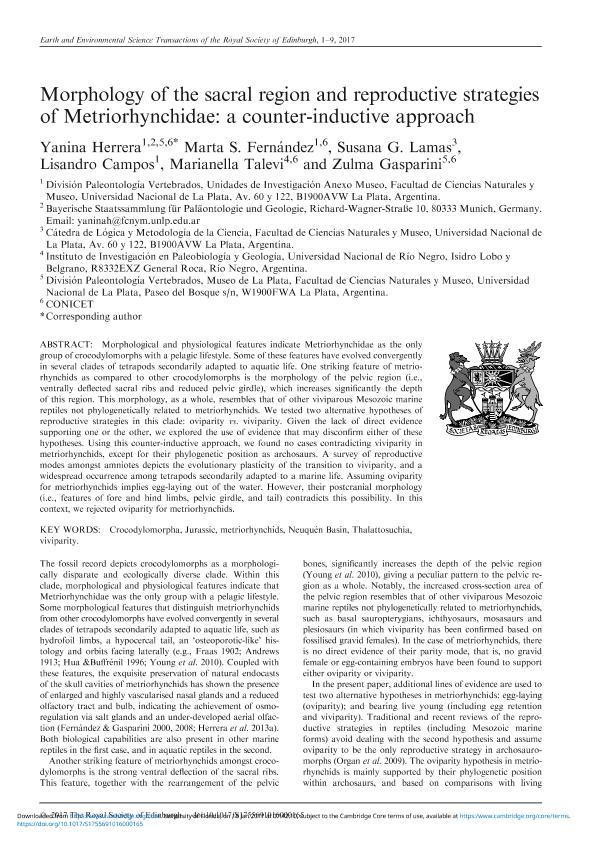Artículo
Morphology of the sacral region and reproductive strategies of Metriorhynchidae: A counter-inductive approach
Herrera, Laura Yanina ; Fernández, Marta Susana
; Fernández, Marta Susana ; Lamas, Susana Gisela; Campos, Lisandro
; Lamas, Susana Gisela; Campos, Lisandro ; Talevi, Marianella
; Talevi, Marianella ; Brandoni, Zulma Nelida
; Brandoni, Zulma Nelida
 ; Fernández, Marta Susana
; Fernández, Marta Susana ; Lamas, Susana Gisela; Campos, Lisandro
; Lamas, Susana Gisela; Campos, Lisandro ; Talevi, Marianella
; Talevi, Marianella ; Brandoni, Zulma Nelida
; Brandoni, Zulma Nelida
Fecha de publicación:
02/2017
Editorial:
Royal Society of Edinburgh
Revista:
Earth and Environmental Science Transactions of the Royal Society of Edinburgh
ISSN:
1755-6910
Idioma:
Inglés
Tipo de recurso:
Artículo publicado
Clasificación temática:
Resumen
Morphological and physiological features indicate Metriorhynchidae as the only group of crocodylomorphs with a pelagic lifestyle. Some of these features have evolved convergently in several clades of tetrapods secondarily adapted to aquatic life. One striking feature of metriorhynchids as compared to other crocodylomorphs is the morphology of the pelvic region (i.e., ventrally deflected sacral ribs and reduced pelvic girdle), which increases significantly the depth of this region. This morphology, as a whole, resembles that of other viviparous Mesozoic marine reptiles not phylogenetically related to metriorhynchids. We tested two alternative hypotheses of reproductive strategies in this clade: oviparity vs. viviparity. Given the lack of direct evidence supporting one or the other, we explored the use of evidence that may disconfirm either of these hypotheses. Using this counter-inductive approach, we found no cases contradicting viviparity in metriorhynchids, except for their phylogenetic position as archosaurs. A survey of reproductive modes amongst amniotes depicts the evolutionary plasticity of the transition to viviparity, and a widespread occurrence among tetrapods secondarily adapted to a marine life. Assuming oviparity for metriorhynchids implies egg-laying out of the water. However, their postcranial morphology (i.e., features of fore and hind limbs, pelvic girdle, and tail) contradicts this possibility. In this context, we rejected oviparity for metriorhynchids.
Archivos asociados
Licencia
Identificadores
Colecciones
Articulos(CCT - LA PLATA)
Articulos de CTRO.CIENTIFICO TECNOL.CONICET - LA PLATA
Articulos de CTRO.CIENTIFICO TECNOL.CONICET - LA PLATA
Articulos(IIPG)
Articulos de INSTITUTO DE INVESTIGACION EN PALEOBIOLOGIA Y GEOLOGIA
Articulos de INSTITUTO DE INVESTIGACION EN PALEOBIOLOGIA Y GEOLOGIA
Citación
Herrera, Laura Yanina; Fernández, Marta Susana; Lamas, Susana Gisela; Campos, Lisandro; Talevi, Marianella; et al.; Morphology of the sacral region and reproductive strategies of Metriorhynchidae: A counter-inductive approach; Royal Society of Edinburgh; Earth and Environmental Science Transactions of the Royal Society of Edinburgh; 106; 4; 2-2017; 247-255
Compartir
Altmétricas



